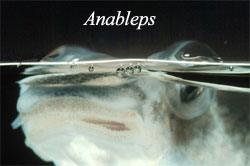
Fish have the usual senses (vision, hearing, tactile, taste and smell) that terrestrial animals do, but they may be modified by adaptations to the aquatic environment. Additionally, the aquatic environment makes possible some unusual senses unknown in terrestrial animals. All sensory perceptions require a "sending unit" that translates physical stimuli such as light and sound into nerve impulses that are sent to the brain where the impulses are interpreted as sight or sound.
Most fishes can see to some extent and some have good vision like most terrestrial animals. The aquatic environment tends to be dimmer and more murky than air, however, and the longer wavelengths of light (red-orange) are rapidly absorbed by water leaving only bluish light at depth. As a consequence, sight is often of limited value underwater and many fishes rely heavily on non-visual senses. A few fish have lost functional eyes through adaptation to permanently dark cave habitat
 |
Some fishes need to be able to see up into the air through the surface of the water in order to detect predators and prey. Light rays bend as they pass from air into water, because of the difference in refractive index, so a fish's view upward into the air is distorted. While everything is visible from horizon to horizon, only objects directly overhead appear accurately. Other objects appear to be higher off the horizon then they actually are. [An Example] This type of view is seen in a photo taken with a "fish-eye" lens, hence the name. Note that fish only have a "fish-eye" view when looking through the surface, not when seeing underwater. A few fish have special adaptations to minimize this distortion. For example, Anableps, is termed the four-eyed fish because the each eye is divided into an upper and lower part with a divided iris. The corneas and lenses of the upper and lower parts are modified to compensate for the different refractive indices of air and water. Anableps swims with the water's surface at the division. [ha]
Fish have both rods and cones in the retina, though rods predominate in fish from dim, deep-water environments. The presence of cones, and pigments that absorb different wavelengths, suggest that fish can see color. Behavioral experiments with a limited number of species confirm this. Sharks accommodate for changing light intensity by dilation and contraction of the iris. Teleosts, however, rely on retinomotor light adaptation, that is, moving the pigment layer and light sensitive rods as light intensity changes.
Sound travels well underwater, and because water is so dense, fish tend to hear well. They have no external ear canals, eardrums or middle ear bones; therefore, sound waves must reach the inner ear by traveling through the body. The innervated cilia that pick up the physical vibrations and transmit a nerve signal to the brain are located in inner ear sacs and have otoliths resting on them. The sound vibrations move the otoliths and the surrounding fish tissue differently. The cilia sense the relative motion and the brain interprets this as sound. Fish do not have a spiral cochlea and so they presumably cannot distinguish frequencies [ha!] as well as we can. The ostariophysan fishes (minnows and catfish) have a mechanical connection of connective tissue, muscle and bone between the gas bladder and the inner ear. This Weberian apparatus serves to amplify sound because the relative motion between the gas in the air bladder and the fish caused by sound waves is greater than between the fish and the otolith. The Weberian apparatus transmits this stronger vibration to the inner ear.
In terrestrial animals, chemoreception is usually divided into taste and smell. The difference being that taste is waterborne and smell is airborne. In fish, all chemical stimuli are carried in the water, so the distinction is blurred. There remains in fish the division of receptors into those in the nasal cavity (smell) and all others (taste) that may occur in the mouth, on barbels, or elsewhere on the body. Fish use chemoreception for finding food, of course, and the ability of sharks and catfish to detect a meal they cannot see is well known. Less appreciated is the role of chemoreception in behavior and orientation. Detection of pheromones is important in breeding and schooling. Some fishes (e.g. minnows) release an alarm substance (Schreckstoff in German) when they are injured that alerts others nearby of danger.
The acuity of chemoreception in homing salmon rivals bloodhounds. It has been shown experimentally that salmon find their way from the main stem of a river to their natal stream by chemoreception. When salmon are small (smolts) in their home stream, they imprint on the subtle unique odors that the watershed gives that particular stream. After migrating downstream and living for years in the ocean, they are able to "sniff" their way home. If the natural stream odors are overwhelmed by a smelly substance, the salmon will imprint on that and later home to wherever the researchers dispense the odoriferous substance. Another experiment showed that blinded salmon could find their way home, but salmon with there nares plugged could not.
Navigation Hint: Press "Alt" and right or left keyboard arrows to move forward and back.